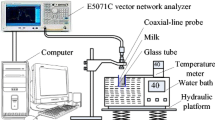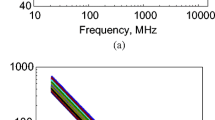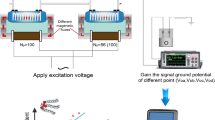Abstract
The aim of the work was to obtain a relationship between the dielectric properties (dielectric constant and dielectric loss factor) of milk and its fat content that could be used to develop a rapid and portable milk fat sensor. The dielectric properties of cow’s milk with a fat content of 0.06–4.04 % were measured from 20 to 4500 MHz at 25–45 °C using a network analyzer and an open-ended coaxial-line probe. The results showed that the values of dielectric constant decreased with increasing either frequency or temperature over their investigated ranges. The values of the dielectric loss factor decreased with increasing frequency to minimums at about 2000 MHz and usually decreased as temperature increased at a given frequency. Both dielectric constant and loss factor had negative linear relationship with the fat content at a given frequency below about 2000 MHz and a temperature between 25 and 33 °C, with the coefficients of determination higher than 0.92 and 0.88, respectively. Compared with the measured fat contents using a standard method, the absolute errors of calculated fat contents using obtained dielectric constant and loss factor at 41 MHz and 25 °C were −0.17~+0.18 and −0.24~+0.43 %, respectively. The study indicates that the fat content of cow’s milk could be determined using obtained permittivity values at a frequency and a temperature.








Similar content being viewed by others
References
Alfaifi, B., Wang, S., Tang, J., Rasco, B., Sablani, S., & Jiao, Y. (2013). Radio frequency disinfestation treatments for dried fruit: dielectric properties. LWT - Food Science and Technology, 50(2), 746–754.
AOAC. (1998). In P. Cunniff (Ed.), Official methods of analysis (16th ed.). USA: Association of Official Analytical Chemists.
Bauman, D. E., McGuire, M. A., & Harvatine, K. J. (2011). Mammary gland, milk biosynthesis and secretion: milk fat. In J. W. Fuquay (Ed.), Encyclopedia of dairy sciences (2nd ed., Vol. 3, pp. 352–358). London: Elsevier.
Bogomolov, A., & Melenteva, A. (2013). Scatter-based quantitative spectroscopic analysis of milk fat and total protein in the region 400-1100 nm in the presence of fat globule size variability. Chemometrics and Intelligent Laboratory Systems, 126, 129–139.
Bohigas, X., Amigo, R., & Tejada, J. (2008). Characterisation of sugar content in yoghurt by means of microwave spectroscopy. Food Research International, 41(1), 104–109.
Coronel, P., Simunovic, J., & Sandeep, K. P. (2003). Temperature profiles within milk after heating in a continuous-flow tubular microwave system operating at 915 MHz. Journal of Food Science, 68(6), 1976–1981.
Everard, C. D., Fagan, C. C., O’Donnell, C. P., O’Callaghan, D. J., & Lyng, J. G. (2006). Dielectric properties of process cheese from 0.3 to 3 GHz. Journal of Food Engineering, 75(3), 415–422.
Fagan, C. C., Everard, C., O’Donnell, C. P., Downey, G., & O’Callaghan, D. J. (2005). Prediction of inorganic salt and moisture content of process cheese using dielectric spectroscopy. International Journal of Food Properties, 18(3), 543–557.
Feng, X.-d., Su, R., Xu, N., Wang, X.-h., Yu, A.-m., Zhang, H.-q., & Cao, Y.-b. (2013). Portable analyzer for rapid analysis of total protein, fat and lactose contents in raw milk measured by non-dispersive short-wave near-infrared spectrometry. Chemical Research in Chinese Universities, 29(1), 15–19.
García, A., Torres, J. L., Prieto, E., & De Blas, M. (2001). Dielectric properties of grape juice at 0.2 and 3 GHz. Journal of Food Engineering, 48(3), 203–211.
Guo, W., Trabelsi, S., Nelson, S. O., & Jones, D. R. (2007). Storage effects on dielectric properties of eggs from 10 to 1800 MHz. Journal of Food Science, 72(5), 335–340.
Guo, W., Zhu, X., Liu, Y., & Zhuang, H. (2010). Sugar and water contents of honey with dielectric property sensing. Journal of Food Engineering, 97(2), 275–281.
Guo, W., Liu, Y., Zhu, X., & Wang, S. (2011a). Dielectric properties of honey adulterated with sucrose syrup. Journal of Food Engineering, 107(1), 1–7.
Guo, W., Zhu, X., Nelson, S. O., Yue, R., Liu, H., & Liu, Y. (2011b). Maturity effects on dielectric properties of apples from 10 to 4500 MHz. LWT - Food Science and Technology, 44(1), 224–230.
Içier, F., & Baysal, T. (2004). Dielectric properties of food materials. 1. Factors affecting and industrial uses. Critical Reviews in Food Science and Nutrition, 44(6), 465–471.
Jiao, S., Johnson, J. A., Tang, J., Tiwari, G., & Wang, S. (2011). Dielectric properties of cowpea weevil, black-eyed peas and mung beans with respect to the development of radio frequency heat treatments. Biosystems Engineering, 108(3), 280–291.
Kent, M., & Anderson, D. (1996). Dielectric studies of added water in poultry meat and scallops. Journal of Food Engineering, 28(3–4), 239–259.
Kucheryavskiy, S., Melenteva, A., & Bogomolov, A. (2014). Determination of fat and total protein content in milk using conventional digital imaging. Talanta, 121, 144–152.
Kudra, T., Raghavan, V., Akyel, C., Bosisio, R., & Van de Voort, F. (1992). Electromagnetic properties of milk and its constituents at 2.45 GHz. Journal of Microwave Power and Electromagnetic Energy, 27(4), 199–204.
Lawton, B. A., & Pethig, R. (1993). Determining the fat-content of milk and cream using ac conductivity measurements. Measurement Science & Technology, 4(1), 38–41.
Li, Z., Wang, N., Raghavan, G. S. V., & Vigneault, C. (2011). Volatiles evaluation and dielectric properties measurements of Chinese spirits for quality assessment. Food and Bioprocess Technology, 4(2), 247–253.
Lizhi, H., Toyoda, K., & Ihara, I. (2008). Dielectric properties of edible oils and fatty acids as a function of frequency, temperature, moisture and composition. Journal of Food Engineering, 88(2), 151–158.
Mabrook, M. F., & Petty, M. C. (2002). Application of electrical admittance measurements to the quality control of milk. Sensors and Actuators B: Chemical, 84(2–3), 136–141.
Mabrook, M. F., & Petty, M. C. (2003). A novel technique for the detection of added water to full fat milk using single frequency admittance measurements. Sensors and Actuators B: Chemical, 96(1–2), 215–218.
Manganiello, L., Rios, A., Valcarcel, M., Ligero, A., & Tena, T. (2000). Automatic determination of fat in milk by use of a flow injection system with a piezoelectric detector. Analytica Chimica Acta, 406(2), 309–315.
Mudgett, R. E., Smith, A. C., Wang, D. I. C., & Goldblith, S. A. (1974). Prediction of dielectric properties in nonfat milk at frequencies and temperatures of interest in microwave processing. Journal of Food Science, 39(1), 52–54.
Nelson, S. O. (2003). Frequency- and temperature-dependent permittivities of fresh fruits and vegetables from 0.01 to 1.8 GHz. Transactions of ASAE, 46(2), 567–574.
Nunes, A. C., Bohigas, X., & Tejada, J. (2006). Dielectric study of milk for frequencies between 1 and 20 GHz. Journal of Food Engineering, 76(2), 250–255.
Pritchard, S. R., & Kailasapathy, K. (2011). Chemical, physical, and functional characteristics of dairy ingredients. In R. C. Chandan & A. Kilara (Eds.), Dairy ingredients for food processing (pp. 35–57). Ames: Blackwell.
Ryynänen, S. (1995). The electromagnetic properties of food materials: a review of the basic principles. Journal of Food Engineering, 26(4), 409–429.
Tang, J., Feng, H., & Lau, M. (2002). Microwave heating in food processing. In X. Young, J. Tang, C. Zhang, & W. Xin (Eds.), Advances in agricultural engineering. New York: Scientific.
Wang, Y., Tang, J., Rasco, B., Kong, F., & Wang, S. (2008). Dielectric properties of salmon fillets as a function of temperature and composition. Journal of Food Engineering, 87(2), 236–246.
Wang, Y., Zhang, L., Gao, M., Tang, J., & Wang, S. (2013). Temperature- and moisture-dependent dielectric properties of macadamia nut kernels. Food and Bioprocess Technology, 6(8), 2165–2176.
Xin, Q., Zhi Ling, H., Jian Long, T., & Zhu, Y. (2006). The rapid determination of fat and protein content in fresh raw milk using the laser light scattering technology. Optics and Lasers in Engineering, 44(8), 858–869.
Zhang, L., Lyng, J. G., & Brunton, N. P. (2007). The effect of fat, water and salt on the thermal and dielectric properties of meat batter and its temperature following microwave or radio frequency heating. Journal of Food Engineering, 80(1), 142–151.
Zhu, X., Guo, W., & Wu, X. (2012a). Frequency- and temperature-dependent dielectric properties of fruit juices associated with pasteurization by dielectric heating. Journal of Food Engineering, 109(2), 258–266.
Zhu, X., Guo, W., Wu, X., & Wang, S. (2012b). Dielectric properties of chestnut flour relevant to drying with radio-frequency and microwave energy. Journal of Food Engineering, 113(1), 143–150.
Zhu, X., Guo, W., & Wang, S. (2013). Sensing moisture content of buckwheat seed from dielectric properties. Transactions of the ASABE, 56(5), 1855–1862.
Zhu, X., Guo, W., & Wang, S. (2014). Dielectric properties of ground hazelnuts at different frequencies, temperatures, and moisture contents. Transactions of the ASABE, 57(1), 161–168.
Zhuang, H., Nelson, S. O., Trabelsi, S., & Savage, E. M. (2007). Dielectric properties of uncooked chicken breast muscles from ten to one thousand eight hundred megahertz. Poultry Science, 86(11), 2433–2440.
Acknowledgments
The authors gratefully acknowledge the financial support from National Natural Science Foundation of China (No. 31171720) and Chinese Universities Scientific Fund (No. ZD2012017, Northwest A&F University).
Author information
Authors and Affiliations
Corresponding authors
Rights and permissions
About this article
Cite this article
Zhu, X., Guo, W. & Liang, Z. Determination of the Fat Content in Cow’s Milk Based on Dielectric Properties. Food Bioprocess Technol 8, 1485–1494 (2015). https://doi.org/10.1007/s11947-015-1508-x
Received:
Accepted:
Published:
Issue Date:
DOI: https://doi.org/10.1007/s11947-015-1508-x




